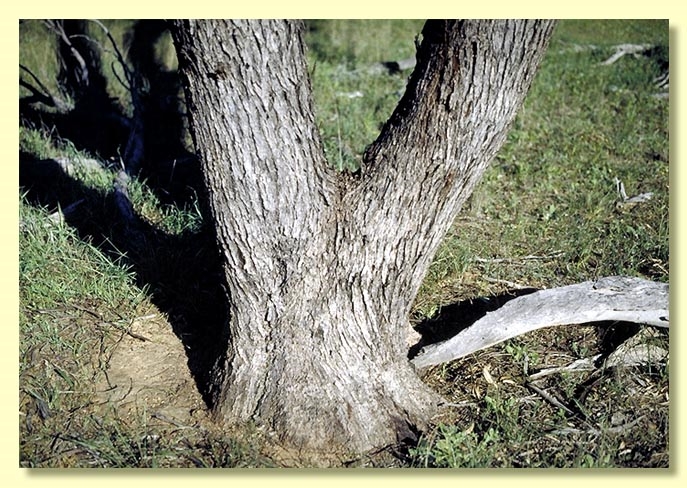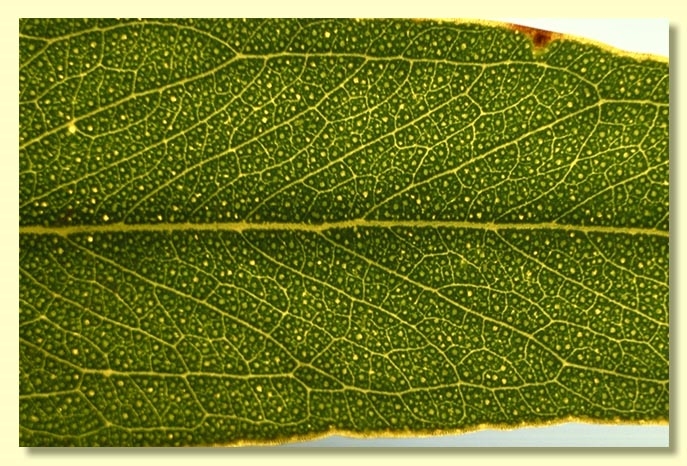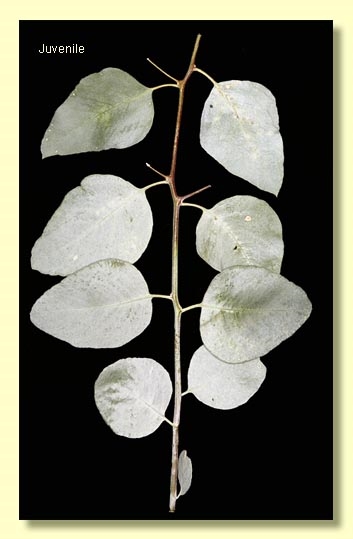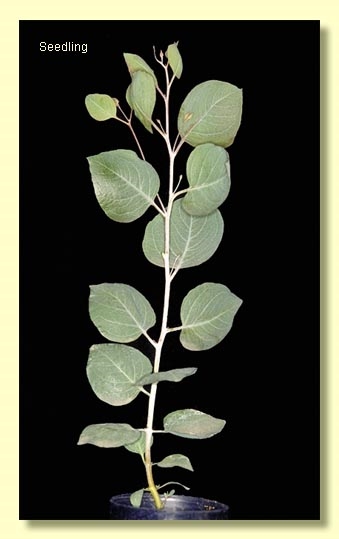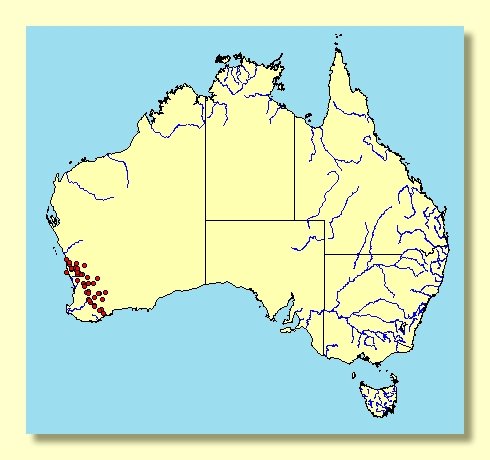Euclid - Online edition
Eucalyptus loxophleba subsp. loxophleba
Classification
Eucalyptus | Symphyomyrtus | Bisectae | Glandulosae | Loxophlebae
Nomenclature
Eucalyptus loxophleba Benth., Fl. Austral. 3: 252 (1867) subp. loxophleba
E. foecunda var. loxophleba (Benth.) Luehm. ex Maiden, Crit. Revis. Eucalyptus 1: 112, pl. 23, figs 1–3; pl. 24 (1904).
T: Western Australia: Swan River Colony, 1843, J.Drummond, 2nd collection, no. 82; lecto K; isolecto: BM, CGE, E, G, NSW, W.
E. foecunda var. loxophleba (Benth.) Luehm. ex Maiden, Crit. Revis. Eucalyptus 1: 112, pl. 23, figs 1–3; pl. 24 (1904).
T: Western Australia: Swan River Colony, 1843, J.Drummond, 2nd collection, no. 82; lecto K; isolecto: BM, CGE, E, G, NSW, W.
Description
Tree or mallee to 15 m tall. Forming a lignotuber.
Bark rough to small branches or less commonly only over most of trunk, shallowly fissured longitudinally giving broad strip appearance, smooth bark olive to brown or purplish.
Branchlets usually non-glaucous, with oil glands in the pith.
Juvenile growth (coppice or field seedlings to 50 cm): stems rounded in cross-section, glaucous; juvenile leaves always petiolate, opposite for 4 to 6 nodes then alternate, deltoid to ovate or orbicular, 4.5–10 cm long, 3.5–9 cm wide, margins often sub-crenulate, glaucous.
Adult leaves alternate, petioles 1–2.5 cm long; blade lanceolate to falcate, 7–15.5 cm long, 1–2(3) cm wide, base tapering to petiole, margin entire, apex pointed, concolorous, glossy, dark green, side veins acute, reticulation usually sparse, intramarginal vein remote from margin, oil glands numerous, island, irregular in outline.
Inflorescence axillary unbranched, or at times apparently terminal compound due to loss of apical vegetative bud, peduncles 0.5–1.5 cm long, buds commonly 7, 9 or 11 per umbel (sometimes to 19), pedicellate (pedicels 0.1–0.5 cm long). Mature buds obovoid to pyriform (0.5–0.8 cm long, 0.3–0.4 cm wide), scar present, operculum rounded, stamens inflexed and their filaments geniculate, anthers cuboid, versatile, sub-basifixed, dehiscing by longitudinal slits, style long and straight, stigma blunt, locules 3 or 4, the placentae each with 4 vertical rows of ovules. Flowers white.
Fruit pedicellate (pedicels 0.2–0.3 cm long), narrowly obconical, 0.4–0.8 cm long, 0.4–0.6 cm wide, disc descending vertically, valves 3 or 4, enclosed.
Seeds brown, 0.7–1.5 mm long, ovoid to more or less cuboid but scarcely angular, dorsal surface shallowly reticulate, hilum ventral.
Cultivated seedlings (measured at node 10): cotyledons Y-shaped (bisected); stems rounded in cross-section, glaucous; leaves always petiolate, opposite for 4 to 6 nodes then alternate, cordate to deltoid or more or less orbicular, 5–7.5 cm long, 3.5–7 cm wide, glaucous to grey-green.
Bark rough to small branches or less commonly only over most of trunk, shallowly fissured longitudinally giving broad strip appearance, smooth bark olive to brown or purplish.
Branchlets usually non-glaucous, with oil glands in the pith.
Juvenile growth (coppice or field seedlings to 50 cm): stems rounded in cross-section, glaucous; juvenile leaves always petiolate, opposite for 4 to 6 nodes then alternate, deltoid to ovate or orbicular, 4.5–10 cm long, 3.5–9 cm wide, margins often sub-crenulate, glaucous.
Adult leaves alternate, petioles 1–2.5 cm long; blade lanceolate to falcate, 7–15.5 cm long, 1–2(3) cm wide, base tapering to petiole, margin entire, apex pointed, concolorous, glossy, dark green, side veins acute, reticulation usually sparse, intramarginal vein remote from margin, oil glands numerous, island, irregular in outline.
Inflorescence axillary unbranched, or at times apparently terminal compound due to loss of apical vegetative bud, peduncles 0.5–1.5 cm long, buds commonly 7, 9 or 11 per umbel (sometimes to 19), pedicellate (pedicels 0.1–0.5 cm long). Mature buds obovoid to pyriform (0.5–0.8 cm long, 0.3–0.4 cm wide), scar present, operculum rounded, stamens inflexed and their filaments geniculate, anthers cuboid, versatile, sub-basifixed, dehiscing by longitudinal slits, style long and straight, stigma blunt, locules 3 or 4, the placentae each with 4 vertical rows of ovules. Flowers white.
Fruit pedicellate (pedicels 0.2–0.3 cm long), narrowly obconical, 0.4–0.8 cm long, 0.4–0.6 cm wide, disc descending vertically, valves 3 or 4, enclosed.
Seeds brown, 0.7–1.5 mm long, ovoid to more or less cuboid but scarcely angular, dorsal surface shallowly reticulate, hilum ventral.
Cultivated seedlings (measured at node 10): cotyledons Y-shaped (bisected); stems rounded in cross-section, glaucous; leaves always petiolate, opposite for 4 to 6 nodes then alternate, cordate to deltoid or more or less orbicular, 5–7.5 cm long, 3.5–7 cm wide, glaucous to grey-green.
Flowering Time
Flowering has been recorded in May, June, July, August, September, October and November.
Notes
Eucalyptus loxophleba is a small to medium-sized tree or mallee species endemic to Western Australia, widespread and common east of the Darling Range in the wheatbelt and goldfields, extending north almost to Shark Bay and south-east to Borden, north of the Stirling Range. It is one of the best known and most widespread species of the more closely settled areas of Western Australia. It has smooth or rough bark and glossy adult leaves with conspicuous side-veins.
Eucalyptus loxophleba belongs to Eucalyptus subgenus Symphyomyrtus section Bisectae subsection Glandulosae because the cotyledons are bisected, buds have an operculum scar and the branchlets have oil glands in the pith. Within this subsection E. loxophleba belongs to a small subgroup of four species, series Loxophlebae, further characterised by having buds with fully inflexed stamens with the staminal filaments geniculate or strongly elbowed and a style that tapers basally, sparsely reticulate glossy green adult leaves and small obconical fruit. The four species are E. loxophleba (four subspecies), E. blaxellii, E. articulata and from north-east of Meekatharra E. semota.
Eucalyptus loxophleba can be separated from both its closely related species and the numerous other species with which it has been recorded growing by its pseudo-terminal young inflorescences that mature within the current crop of leaves and also by its glaucous, broadly ovate to deltoid juvenile leaves which are frequently seen on roadsides. Unlike E. articulata, E. blaxellii and E. semota, E. loxophleba does not have the base of the style articulated (jointed) within the ovary roof.
There are four subspecies, largely delineated on bark characters:
E. loxophleba subsp. loxophleba
This is the well known York Gum of the western part of the wheatbelt from Moora in the north, south to Kojonup and eastwards to about Merredin and Hyden. It is a tree with rough bark over the whole trunk.
E. loxophleba subsp. lissophloia
A smooth-barked mallee of the eastern wheatbelt and the goldfields, extending from Bencubbin and Merredin east as far as Karonie (Cardunia Rocks), Coonana, and almost to Balladonia and to Peak Charles. The branchlets are usually glaucous. It often occurs in wet depressions.
E. loxophleba subsp. gratiae
A smooth-barked, large-leaved form with the large buds and fruit. It occurs in the southern wheatbelt from Nyabing to east of Hyden.
E. loxophleba subsp. supralaevis
This is the tree of the northern wheatbelt, from Westonia and Mt Jackson north-west to Wannoo near Shark Bay. The trunk is rough-barked in the lower half only, with a clearly marked transition from rough bark to smooth bark.
Eucalyptus loxophleba belongs to Eucalyptus subgenus Symphyomyrtus section Bisectae subsection Glandulosae because the cotyledons are bisected, buds have an operculum scar and the branchlets have oil glands in the pith. Within this subsection E. loxophleba belongs to a small subgroup of four species, series Loxophlebae, further characterised by having buds with fully inflexed stamens with the staminal filaments geniculate or strongly elbowed and a style that tapers basally, sparsely reticulate glossy green adult leaves and small obconical fruit. The four species are E. loxophleba (four subspecies), E. blaxellii, E. articulata and from north-east of Meekatharra E. semota.
Eucalyptus loxophleba can be separated from both its closely related species and the numerous other species with which it has been recorded growing by its pseudo-terminal young inflorescences that mature within the current crop of leaves and also by its glaucous, broadly ovate to deltoid juvenile leaves which are frequently seen on roadsides. Unlike E. articulata, E. blaxellii and E. semota, E. loxophleba does not have the base of the style articulated (jointed) within the ovary roof.
There are four subspecies, largely delineated on bark characters:
E. loxophleba subsp. loxophleba
This is the well known York Gum of the western part of the wheatbelt from Moora in the north, south to Kojonup and eastwards to about Merredin and Hyden. It is a tree with rough bark over the whole trunk.
E. loxophleba subsp. lissophloia
A smooth-barked mallee of the eastern wheatbelt and the goldfields, extending from Bencubbin and Merredin east as far as Karonie (Cardunia Rocks), Coonana, and almost to Balladonia and to Peak Charles. The branchlets are usually glaucous. It often occurs in wet depressions.
E. loxophleba subsp. gratiae
A smooth-barked, large-leaved form with the large buds and fruit. It occurs in the southern wheatbelt from Nyabing to east of Hyden.
E. loxophleba subsp. supralaevis
This is the tree of the northern wheatbelt, from Westonia and Mt Jackson north-west to Wannoo near Shark Bay. The trunk is rough-barked in the lower half only, with a clearly marked transition from rough bark to smooth bark.
Origin of Name
Eucalyptus loxophleba: Greek loxo- and phleba, with slanting veins, which is hardly diagnostic although the veins are conspicuous in the fresh leaf.
Copyright © CANBR 2020, all rights reserved.

Web edition hosted at https://apps.lucidcentral.org/euclid

